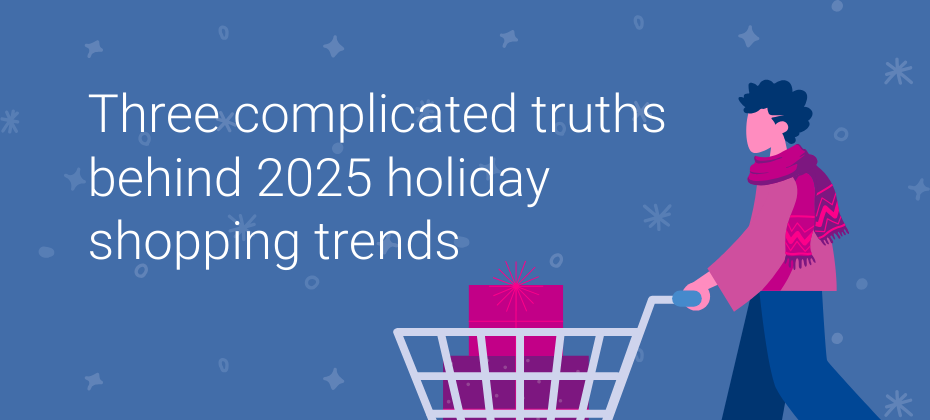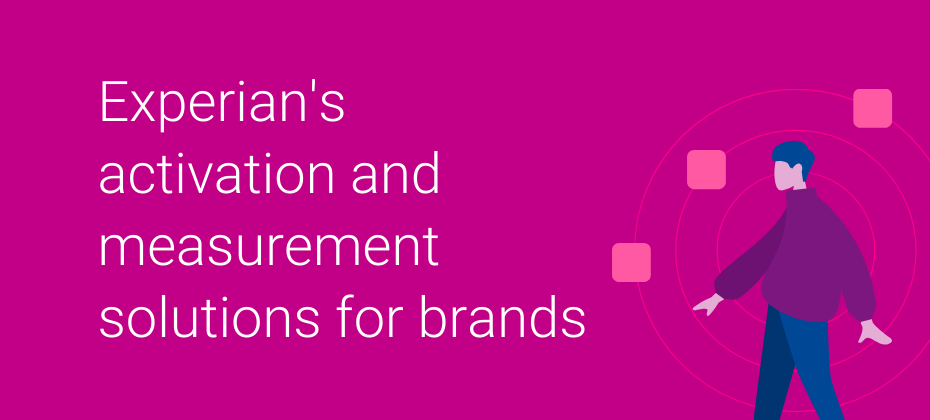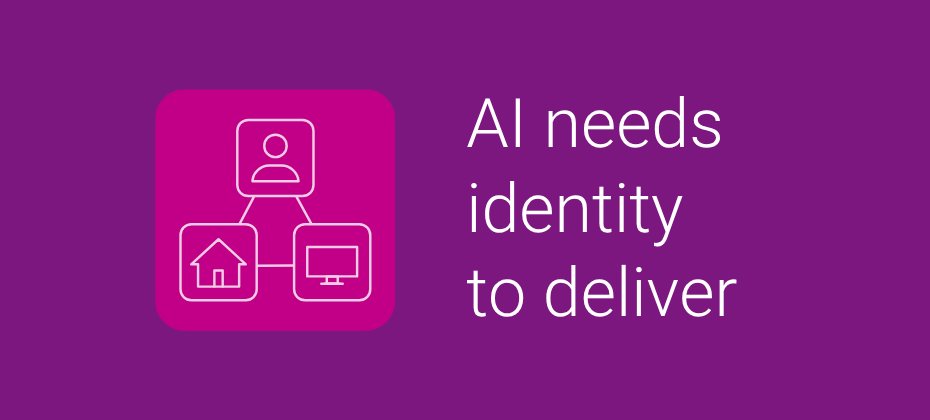All posts by Hayley Schneider, Sr. Manager, Content Marketing

Personalization without context misses the moment Marketers have spent years perfecting personalization — but personalization alone often misses the mark. We’ve all seen it. You shop for a weekend getaway, then get served travel ads weeks later when you’re already home. The data was right. The timing wasn’t. Personalization based only on identity and behavior knows who you are but not when or why you’re ready to act. At Experian, we believe AI should make marketing feel more human. That means understanding people in context, recognizing their environment, mindset, and the moment, to create relevance that feels timely, not intrusive. The context gap: Why identity and behavior aren’t enough Identity and behavioral data can reveal the kind of consumer someone is and the kind of products they may want to buy. But they don’t explain what’s happening right now. The missing layer is context: the dynamic, real-time signal that shows why this moment matters. Context bridges the gap between knowing something about a consumer and understanding their intent. In an era of fragmented signals and stricter privacy rules, context is one of the most reliable ways to stay relevant without over-reliance on personal identifiers. It helps marketers adapt to shifting needs while keeping privacy intact. How Experian interprets context in real-time By context, we mean all the subtle, in-the-moment signals, like time of day, location, or what someone’s watching, that shape what people care about in real-time. At Experian, our technology interprets these in real-time: Temporal signals Time-based patterns such as daypart (morning vs. evening), recency (how fresh a signal is), seasonality (holidays, life events), and micro-moments (split-second intent-driven actions). Environmental signals The media or content environment; what type of program, article, or channel someone is engaging with when they see your ad. Situational intent Signals like browsing behavior or purchase patterns that hint at a person’s stage in the buying journey, from early research to final decision. By layering these signals over verified identity and behavioral data, Experian’s AI-powered technology helps marketers predict not just who will act, but when they’re ready to act. Experian’s approach: Turning context into relevance Consumer behavior changes by the minute, and marketers need to adapt just as quickly. Our technology interprets live bidstream data, device activity, content, and timing to optimize in the moment, ensuring your campaigns deliver meaningful relevance, not just broader reach. Our process combines: Input Clean, accurate identity and audience data anchored in our privacy-first framework. Enrichment Our models fuse household, device, and publisher context to reveal moment-based intent. Activation We're investing in agentic workflows that help marketers plan and execute performance campaigns at scale, activated via our real-time technology that dynamically adjusts deals and surfaces contextually aligned opportunities. Governance Every signal and recommendation follows Experian’s principles of transparency, consent, and ethical oversight. We call this AI-powered simplicity tools that help marketers work more efficiently, with intelligence that feels intuitive and human-centered. How context changes the game for marketers AI without real-time context can only react based on what it already knows. AI-powered by in-the-moment contextual data points enables marketers to anticipate, not just react. A travel brand can shift creative from “dreaming” to “booking” mode when AI detects signals of active planning. A retailer can align promotions with trending content or regional weather shifts in real time. A CPG brand can trigger different product messages based on the context of recipes or household occasions. Adjustments based on contextual signals compound into meaningful gains — higher engagement, better efficiency, and a consumer experience that feels natural rather than intrusive. Context makes AI more human Context introduces empathy into automation. It’s what keeps AI from overstepping, ensuring the message fits the moment. When marketers respect timing, environment, and intent, ads feel like service, not surveillance. Context transforms relevance into respect. At Experian, our vision is to make every signal serve people, not profiles. Because the more our technology (including our AI tools and capabilities) understands context, the more human marketing becomes. At Experian, responsible intelligence is built in Every contextual model we deploy adheres to our standards for transparent and responsible innovation. We validate inputs, monitor model drift, and ensure no context-based variable introduces bias or privacy risk. This is what responsible automation looks like in practice: intelligent, explainable, and ethical. From who to when: Context is the future of AI-driven marketing Identity tells us who someone is. Context tells us when it matters. The next wave of AI-driven marketing will unite privacy-first identity with contextual intelligence to deliver real-time relevance, responsibly. At Experian, we’re building that future now. Our AI-driven capabilities bring identity, insight, and generative intelligence together so brands, agencies, and platforms can reach the right people, at the right moment, with relevance and respect. Get started now About the author Matthew Griffiths SVP of Technology, Audigent, a part of Experian Matthew Griffiths is a seasoned technology entrepreneur and a driving force in advertising technology, data technology, and AI. As the Co-Founder and former CTO (now SVP of Technology) at Audigent, a part of Experian, he plays a pivotal role in shaping the company’s cutting-edge solutions for data activation, curation, and identity management. With years of executive experience across the U.S., Africa, and the U.K., Matthew has a proven track record of leadership in steering the adoption and use of cutting-edge technologies to drive business outcomes. His expertise spans from collaborating with top global corporations and governments to spearheading award-winning technology projects that deliver life-changing impacts in some of the world's most underserved communities. Matthew’s dynamic approach to solving complex business and technology challenges makes him a visionary leader in the AdTech space, consistently driving innovation and performance through technology. FAQs How does context make AI-driven marketing more effective? Context makes AI-driven marketing more effective because it helps marketers understand people in context, recognizing their environment, mindset, and the moment, to create relevance that feels timely, not intrusive. Context helps marketers understand not just who a person is, but when and why they’re ready to act. Experian’s AI-powered technology layers contextual signals over verified identity data to deliver relevance that feels intuitive, not invasive. This approach connects recognition with understanding, making every campaign more effective and more human. What is the context gap in AI-driven marketing? Identity and behavioral data can reveal the kind of consumer someone is and the kind of products they may want to buy. But they don’t explain what’s happening right now. That’s the context gap—the missing link between knowing something about a consumer and understanding their intent. Context closes this gap by analyzing environmental, temporal, and situational signals that reveal intent—without using invasive identifiers. Does Experian interpret contextual signals in real-time? Yes, at Experian, our technology interprets contextual signals, including temporal, environmental, and situational, in real-time. By layering these signals over Experian’s verified identity and behavioral data graph, marketers can predict when consumers are most receptive, turning data into real-time opportunity. What does responsible intelligence look like in practice? At Experian, every contextual model we deploy adheres to our standards for transparent and responsible innovation. We validate inputs, monitor model drift, and ensure no context-based variable introduces bias or privacy risk. What does Experian’s foundation in responsible automation look like? - Privacy-first clarity: We unify household, individual, device, demographic, behavioral, publisher first-party signals, and contextual data points to build a reliable view of consumers, even when certain signals are missing. This clarity helps marketers personalize, target, activate, and measure with confidence.- Predictive insight: Our models go beyond describing the past. They forecast behaviors, fill gaps with inferred attributes, create lookalikes, and recommend next-best audiences so clients can anticipate opportunity.- AI-powered simplicity: We’re investing in generative AI and exploring emerging agentic workflows to reimagine how marketers work. Our vision is to move beyond basic audience recommendations toward intelligent audience discovery and automated setup, helping teams uncover opportunities they may not have considered, while spending less time on manual work and more time on strategy and outcomes.- Real-time intelligence: Consumer journeys never stand still. Our AI-powered technology interprets live bidstream data, device activity, content, and timing to optimize in the moment, ensuring campaigns deliver meaningful relevance, not just broader reach.- Transparent and responsible innovation: We drive safe, modular experimentation, from generative applications to agentic workflows, always balancing bold ideas with ethical guardrails. We stay at the forefront of evolving legislation and regulation, ensuring our innovations protect consumers, brands, and the broader ecosystem while moving the industry forward responsibly. Latest posts

Originally appeared in Adweek This holiday advertising season, identity is the real differentiator Marketers are betting big on AI to run their holiday advertising, using it to build predictive audiences, generate creative at scale, and optimize media buys in real time. The draw is clear: greater efficiency, delivered at scale. But here’s the problem: without a solid identity foundation, AI is just guessing. And in a year when consumers are cautious and competition is fierce, guesses won’t deliver the outcomes you need. Experian’s 2025 Holiday spending trends and insights report shows that success this season will depend on connecting the right data to the right audiences in real time. Download the report now Are shoppers really using AI to make holiday purchases? Not yet. Only 12% of consumers plan to use AI tools to shop this season, mostly for finding discounts. Instead, trusted influences (like retailer websites, product reviews, and recommendations) still guide buying decisions. For marketers, that’s a signal to focus on credibility and connection. AI can support your holiday advertising strategy, but trust still wins the sale. Consumer sentiment heading into the holidays is low, but that could mislead marketers Here's why How marketers are really using AI in holiday advertising Behind the scenes, AI is working overtime. Teams use it to segment audiences, test creative, and optimize media in real time. These capabilities are powerful, but only if they’re grounded in accurate, persistent data. Think about the typical holiday shopper. They may browse a product online, validate it in store, and finally purchase days later from a different device than they used while browsing. If AI isn’t anchored in identity, it struggles to connect those touchpoints. Instead of amplifying relevance, it amplifies noise. See our predictions for Black Friday 2025 Why identity is the GPS for AI-driven holiday advertising Identity is what turns AI from a blunt instrument into an accurate tool. By unifying fragmented signals across channels and devices, identity provides the consistent consumer view that AI needs to be effective. With that foundation, AI can do more than churn out models. Instead, it can: Identify the right audiences and filter out waste Personalize with context, not just scale Measure real outcomes, linking exposures to visits and purchases Identity doesn’t just improve efficiency; it creates accountability. And in a season where every holiday advertising campaign dollar is scrutinized, accountability is the difference between investment and waste. Why connected data will make or break Cyber Week How to turn complexity into clarity this holiday season This year's holiday advertising season is complicated. Marketers are confident, consumers are cautious, and AI is somewhere in the middle. The challenge isn’t just speed or volume, it’s accuracy. By pairing AI with identity, you can adapt to real behavior instead of assumptions. You can build campaigns that are consistent across connected TV, retail media, and social platforms. And you can prove results when it matters most. AI isn’t a holiday miracle. But when it’s powered by identity, it can give you clarity in a noisy season and proof of performance when budgets are under scrutiny. Explore Experian's holiday audiences to activate this season What’s the real takeaway for marketers this season? Don’t assume AI alone will save your holiday advertising strategy. It won’t. Consumers still trust human voices more than machines, and your AI models are only as strong as the data beneath them. Identity is the difference between guesswork and accuracy, between activity and impact. This holiday season, the winners won’t be the brands that simply spend more or automate faster. They’ll be the ones that put identity at the core of their AI strategy and meet consumers where they really are. Download Experian’s 2025 Holiday spending trends and insights report to see where consumers are spending and how identity can help your holiday advertising campaigns more effective. Download now About the author Colleen Dawe VP, Advertiser Partnerships, Experian Colleen Dawe is VP, Advertiser Partnerships at Experian Marketing Services, where she oversees revenue growth and client success, helping advertisers harness data and identity to fuel marketing strategies. With over 15 years of experience spanning TV and digital media, she brings deep expertise in data, identity, activation, and measurement to help her clients connect innovation with business outcomes. Holiday advertising FAQs Why isn’t AI enough on its own for holiday advertising? AI works best when it’s grounded in accurate data. Without identity, it can’t connect actions across devices or channels, which limits its effectiveness. How does identity improve AI-driven campaigns? Identity creates a single, persistent view of your audience. That means AI can personalize content, measure conversions, and cut waste with far greater accuracy. What does “identity” mean in marketing terms? It’s the data layer that connects people across their devices, browsers, and behaviors—so your campaigns reach real individuals. How can marketers prove ROI in holiday advertising? By tying exposure to verified outcomes—like store visits or purchases—using identity-linked data. That’s how Experian helps brands move from impressions to impact. Latest posts

What challenge did the pet brand face? A national e-commerce pet supplier wanted to expand into audio advertising to diversify beyond display campaigns. But with only one team member available to test this new channel, they faced three hurdles: Prove performance in a new channel Run lean with limited bandwidth Show purchase intent, engaged site visits, and completion rates fast They needed a partner to handle execution and supply optimization so their lean team could focus on strategy and selling audio internally. Hear how we're working with Audacy to help our clients connect beyond the screen Tune in here The solution: How did Experian Curated Deals help? Audigent, a part of Experian, ran point on setup, optimization, and real-time reporting. The brand turned to Experian Curated Deals. Together we: Streamlined access to curated inventory, cutting intermediaries and boosting efficiency Handled campaign setup and supply-side optimization Delivered real-time demand-side platform (DSP) reporting for agile targeting refinements Provided an extension of their in-house team, giving them bandwidth to focus on pitching audio internally “What stood out about Experian was their real-time control and the depth of their trading team. I knew I could hand them a campaign, and they’d run with it.”Programmatic Media Lead, National e-commerce pet supplier Want to see the full case study? Download it here What results did the campaign deliver? In just a few months, audio transformed from a small test into a top-performing channel: Exceeded KPIs by 63% Increased purchase intent and engagement vs. competing platforms Matched display performance without creative refreshes or incentive overlays Earned budget increases, positioning audio as a long-term investment Reduced internal setup time, freeing the team for strategic projects “Experian became more than just a media partner: they filled critical gaps that would typically require outsized investment in internal resourcing.”CMO, National e-commerce pet supplier Explore more examples of how brands are driving performance with Experian Windstar Cruises Leading athletic retailer Swiss Sense Why does this matter for marketers? For marketers, audio isn’t experimental anymore. It’s a proven channel that can drive both engagement and conversions. This case study shows how brands can: Use Experian Curated Deals to validate new channels with minimal risk. Lean on Experian to handle execution, freeing teams to focus on growth. Drive meaningful engagement and purchase intent, not just impressions. For marketers navigating limited resources and pressure to prove ROI fast, Experian Curated Deals provides both performance and confidence. Want to beat your campaign goals by double digits? Contact us today Curated Deals FAQs What is Experian Curated Deals? Experian Curated Deals streamline access to premium media inventory by eliminating unnecessary intermediaries, optimizing efficiency, and ensuring campaigns perform against KPIs. Why use curated deals for audio advertising? Curated deals help brands test and validate audio quickly, without the heavy lift of manual setup and supply path management. Can audio really drive conversions? Yes. In this case, audio campaigns not only exceeded awareness and engagement goals but also matched the conversion performance traditionally associated with display. How does Experian support lean teams? By managing setup, supply optimization, and reporting, Experian acts as an extension of your team, reducing internal workload while driving performance. Latest posts

AdTech jargon can feel overwhelming, but we're breaking it down café-style. From first-party data and identity resolution to clean rooms and ID-free targeting, here are the essential terms marketers need to know.

Holiday shopping in 2025 feels a lot like a complicated relationship. Shoppers want deals, but they also want trust. They start shopping early, but they’re still browsing well into December. They love the convenience of online shopping, but they still show up in-store before making the final call.

Marketers aren’t thinking in channels anymore: they’re thinking in audiences. As consumer media habits have scattered across devices, platforms and formats, brands have shifted their focus from managing one channel at a time to delivering a connected experience. That’s the core of omnichannel marketing: meeting people where they are and making each touchpoint feel like part of a larger narrative. However, most brands still encounter the same roadblocks: siloed data, fragmented planning and tools that don’t integrate. And while the industry talks a great deal about omnichannel marketing, few are actually doing it well. The brands that figure it out won’t just reach more people; they’ll improve brand perception while improving the customer journey, achieving better outcomes, and optimizing their media spend more efficiently. Learn more about this trend in our 2025 Digital trends and predictions report. Learn more Why omnichannel is no longer optional Omnichannel marketing has long been a goal, but recent shifts in media and technology now make it a necessity. According to Forrester, 21% of global B2C business and tech professionals identified enhancing omnichannel or cross-channel customer experiences as a top priority for their organization today. Connected TV (CTV) and commerce media networks are emerging as dominant channels, necessitating the coordination of messaging across an expanding ecosystem of streaming, programmatic display, and commerce-driven environments in addition to the multitude of other addressable (and non-addressable) channels. Fortunately, identity solutions continue to evolve, enabling marketers to maintain audience addressability in digital channels even as traditional signals decline and privacy regulations intensify. Consumers expect this kind of cohesion. They don’t see “channels" - they just see a brand. A member of your loyalty program might browse a product online, see the exact item later on their socials, and then receive an email offer. If those messages feel disconnected or out of sync, this will not be a good customer experience, and a brand risks wasting impressions and losing conversions. Omnichannel isn’t about showing up in more places. It’s about showing up with a consistent message. The opportunities inherent in true omnichannel execution Despite the industry’s movement toward omnichannel marketing strategies, there are a few untapped opportunities brands would benefit from pursuing. Break down planning silos to optimize performance Many marketers still plan and measure media in silos: programmatic display, CTV, commerce media, search, social, email, SMS, and each might have their own budgets, strategies, and KPIs. This disjointed approach leads to inconsistent messaging, inefficient spend, and overexposure or underexposure to key audiences. The opportunity? Shift toward integrated media planning and measurement. By aligning teams and KPIs across channels, marketers can optimize frequency, coordinate creative sequencing, and better attribute business outcomes. Breaking down internal silos improves the customer experience and drives more effective performance. With two-thirds of North American CMOs naming siloed data as their biggest obstacle, those who solve it stand to gain a clear advantage. Encourage interoperability to activate audiences consistently Omnichannel success depends on defining an audience once and reaching them everywhere. But in today’s ecosystem, where walled gardens control inventory and many tools remain disjointed, this is easier said than done. Just under a third of marketers say the tools they use don’t work well together. The opportunity? Invest in interoperable systems that give you control over your data and privacy-safe solutions like clean rooms or universal IDs that enable consistent audience activation across platforms. Advocate for a unified identity framework Audience data remains fragmented: commerce media networks control shopper data, TV platforms hold viewership data, and walled gardens provide limited data transparency and determine which data they will share, making it difficult to recognize, reach, and follow the customer journey across digital touchpoints. Without a unified view, campaigns remain disconnected and cross-channel attribution is difficult. The opportunity? Advocate for a centralized, privacy-conscious identity framework that bridges fragmented data sources. This would allow marketers to recognize consumers across platforms and deliver cohesive messaging. Marketers need solutions that enable connected audience activation while respecting privacy requirements and platform-specific constraints. Without this, omnichannel remains an aspiration rather than a reality. Data and identity: The tools you need in your toolkit to make omnichannel work Implementing omnichannel right starts with establishing identity. Brands need a foundation that lets them connect the dots: across data, platforms and channels. Here’s how: Build a unified identity foundation “A single view of the customer is the foundation of a successful omnichannel program,” says Forrester in a December 2023 report on omnichannel. This begins by connecting disparate data sources, including persistent offline information, such as addresses, emails, names, and phone numbers, with digital signals, in a privacy compliant way. And this, in turn, creates a strong identity foundation. Solutions that integrate hashed email addresses (HEMs), mobile ad IDs (MAIDs), IP addresses, CTV IDs, and universal IDs enable brands to resolve customer identities across different platforms, ensuring that campaigns remain addressable as users transition between channels. Activate audiences everywhere, without the hassle Brands should be able to define an audience once and activate it across all addressable channels without unnecessary complexity. Interoperability between demand-side platforms (DSPs), supply-side platforms (SSPs), clean rooms, and private marketplaces (PMPs) ensures that high-quality audiences are matched with premium inventory in a targeted, transparent, and efficient manner. This connectivity helps maintain consistent audience targeting—even as consumers engage in different environments. By working with a partner that seamlessly integrates with major platforms, marketers ensure that data quality and identity resolution remain intact throughout campaigns, avoiding data loss that occurs when data is transferred between different, disparate platforms. Measure across channels, and the customer journey Effective omnichannel marketing isn’t just about reaching audiences—it’s about understanding how different touchpoints contribute to conversions. Advanced attribution models, incrementality testing, and cross-platform frequency management enable brands to use consistent identity across campaign planning, activation and measurement so they connect ad exposures to real-world outcomes. Achieving this requires a strong identity resolution partner—one that can unify audience data across environments and power accurate, privacy-compliant measurement at scale. The future of omnichannel marketing Omnichannel is becoming the baseline expectation for modern marketing. The brands that figure out how to connect the dots across the increasingly disparate media landscape will drive better performance and build stronger customer relationships. By working with a partner that can offer you an end-to-end data and identity solution focused on consumers, not channels, you can better understand your best customers (and your next customers), reach them across channels, and measure cross-channel campaigns more effectively, making true omnichannel execution more achievable. Get started today About the author Kimberley Klevstad Account Director, Retail, Experian Kimberley Klevstad is 25-year industry veteran with a wide range of experience driving strategic growth for global accounts across print, online, mobile, location-based and streaming audio platforms. Kimberley is currently a member of the Experian Marketing Services Retail team, advising top retail brands on data and identity strategies that will deepen loyalty and drive acquisition in an increasingly competitive landscape. Latest posts

Brands want more from their media investments: better insights, more efficient reach, and clear proof of performance. Whether you’re starting with high-quality first-party data or need help reaching new audiences, Experian offers flexible solutions to drive reach among key audiences and to measure the impact. We’ve built two primary activation and measurement solutions tailored to how brands operate, so you can spend less time managing data and more time driving outcomes. Use case 1: First-party insights to activation and measurement Best for: Brands with first-party data looking to deepen their understanding of existing customers, activate intelligently, and measure what matters – all through a single trusted partner. Solution: Audience Engine + Outcomes Audience Engine Audience Engine is our self-service platform designed to help you onboard first-party data, gain key insights into your customers, build custom audiences using our powerful data assets, and activate them across 200+ platforms — all within a single workflow. Outcomes Experian Outcomes closes the loop by measuring real-world results of your campaigns (such as visits, purchases, and website actions) and tying them back to specific media exposures across digital and TV channels. Together, these tools offer a full-funnel audience and measurement solution, from planning and activation to proving performance. Let’s bring this to life A leading athletic retailer partnered with Experian and Yieldmo to drive in-store foot traffic, targeting shoppers likely to buy from their competitors during key sales windows. Using Experian’s Audience Engine, which includes our proprietary and third-party data marketplace, Yieldmo built a high-performing, self-serve targeting strategy for the retailer. By combining Experian Audiences with Partner Audiences from Alliant, Circana, Webbula, and Sports Innovation Lab, Yieldmo was able to build apparel and footwear audiences from the data marketplace including: In-store shopper segments Athleisure purchasers Competitive purchasers Audience Engine also enabled Yieldmo to tap into Experian’s identity graph, expanding cross-channel reach and maximizing campaign scale and precision. And while not used for this campaign, our Outcomes solution allows advertisers to tie media spend to in-store activity, so retailers can measure true business impact. Benefits Understand your customers more deeply To reveal behavioral, demographic, and lifestyle trends. Reach your first-party audiences at scale Across top activation platforms, using Audience Engine’s onboarding capabilities. Increase your brand awareness By reaching prospective audiences, using Experian Audiences, Partner Audiences, and lookalike audiences. Measure campaign effectiveness With Outcomes, which correlates media exposures (digital and/or TV) with offline and online conversions, visits, or sales. Optimize future media buys By using attribution insights to refine targeting, creative, and channel mix based on what’s actually driving results. Use case 2: Activation and measurement Best for: Brands that already know who they want to reach and are looking to activate high-quality, data-driven audiences across their preferred media platforms and want to clearly understand what’s driving performance. Solution: Audiences + Partner Audiences + Outcomes Audiences Experian Audiences are pre-built audience segments grouped by shared attributes from Experian Marketing Data built for activation on-the-shelf of top programmatic, TV, and social destinations like FreeWheel, Magnite, and Madhive, in addition to Audience Engine. Partner Audiences Experian's Partner Audiences are high-quality audience segments sourced directly from 30+ leading third-party data providers like Affinity, Circana, and Dun & Bradstreet. These segments are curated across verticals like Business, CPG, Health, Retail, and Travel, and are available through on top media destinations, in addition to our data marketplace for easy selection and deployment. Outcomes Experian Outcomes helps close the loop by tying real-world results back to media exposures across digital and TV channels. Together, these products empower marketers to activate smarter and prove success with confidence. Let's bring this to life A leading fashion brand set out to grow their customer base by reaching high-intent shoppers where they spend their time: online. Their goal: drive e-commerce conversions through a programmatic campaign powered by The Trade Desk. To do it, they needed more than just reach, they needed accuracy. That’s where Experian came in. On The Trade Desk, the brand quickly discovered Experian’s prebuilt audience segments, readily available and easy to activate. They selected: Age Range: 25–44 Women’s Fashion Frequent Spenders: Households identified as frequent purchasers of women’s apparel, cosmetics, jewelry, and accessories—based on verified, consumer-reported transactions from the past 24 months. These segments gave the brand confidence that it was putting its message in front of the right consumers, those most likely to engage and buy. To understand whether their campaign was driving results beyond impressions, the brand implemented a site pixel to capture both top-of-funnel visitation and bottom-of-funnel conversions. Using Experian’s Outcomes solution, they were able to close the loop—tying ad exposure directly to e-commerce sales. The Outcomes report showed clear campaign lift, highlighting which channels and audience segments performed best. Armed with these insights, the brand refined their targeting and messaging for future media buys—boosting ROI with each iteration. Benefits Reach your ideal audience at scale By activating Experian Audiences and Partner Audiences off the shelf at digital and TV platforms. Access privacy-conscious, diverse data Curated by 30+trusted data providers in verticals like Business, CPG, Health, Retail, and Travel without needing to manage multiple data contracts. Understand what’s working Through Outcomes reporting, which connects media exposure to offline and online outcomes like conversions, purchases, or visits. Continuously improve performance By using attribution insights to inform audience selection, creative strategy, and media channel mix for future campaigns. Bring this to your brand Experian’s activation and measurement solutions for brands gives you the tools to act with clarity: from onboarding your first-party data to reaching new customers and tying media back to real results. Whether you’re starting with deep customer insights or building campaigns from scratch, here’s how our solution helps: Audience Engine Onboard your first-party data, gain insights into audience composition, build custom audiences using Experian and Partner Audiences, and activate them across 200+ leading platforms — all through a centralized, self-service platform. Audiences and Partner Audiences Reach high-intent prospects using Experian’s syndicated audiences or custom-built segments from partners like Circana, Dun & Bradstreet, and more. Outcomes Understand what worked. See how media exposure correlates with actions like store visits, quote requests, site activity, or purchases. Every element is built to help you scale campaigns, improve addressability, and tie media spend to results that matter—without the overhead of multiple vendors or disjointed systems. Ready to see it in action? Get in touch with our team. Latest posts

Marketers are searching for better ways to connect with their audiences across screens and prove results. Optimum Media is at the forefront of this development, helping brands plan, activate, and measure campaigns across linear TV, addressable TV, connected TV (CTV), digital, and social platforms. To support this approach, Optimum Media partners with Experian, combining their subscriber data with Experian’s trusted audience and identity solutions. Together, we help brands not only find the right consumers but also understand their behaviors and measure real outcomes. Here’s how Optimum Media and Experian are working together. Build a complete customer view with rich data from Experian Optimum Media starts with strong first-party data, including viewership and exposure information from millions of households. However, reaching a deeper understanding of these audiences requires more than what subscriber records alone can offer. Through Experian’s Marketing Attributes, Optimum Media gains access to thousands of demographic and behavioral attributes to its data sets. These attributes—such as income ranges, lifestyle interests, and retail purchasing behaviors—help advertisers build a more complete view of the consumer. "We work with trusted partners like Experian to deliver the additional audience insights—like demographics and lifestyle—that are critical for our clients' success."Natalia Irmin, Sr. Director, Strategic Partnerships, Optimum Media Combining Experian’s Marketing Attributes with Optimum Media’s subscriber footprint helps brands segment audiences more precisely, develop refined media plans, and tailor messaging based on the real behaviors and interests of consumers. Move beyond basic targeting with Audience Engine To support more personalized and scalable targeting, Optimum Media uses Audience Engine—Experian’s self-service platform for audience management and activation. Through Audience Engine, Optimum Media can: Access Experian’s syndicated audiences Not just what’s available directly on their platform. Build custom segments Using Experian’s demographic and behavioral insights. Tap into our data marketplace To explore additional segments from Experian and our Partner Audiences through trusted third-party providers. These tools give Optimum Media and its clients the ability to move beyond basic targeting. Whether a brand wants to reach families preparing for back-to-school shopping, in-market car buyers, or upscale consumers planning home renovations, Audience Engine makes it possible to identify and activate those audiences with greater accuracy—based on real data, not guesswork. Extend campaign reach with Experian’s Digital Graph While Optimum Media has a substantial owned footprint, they often work with advertisers who need to extend reach beyond traditional subscriber bases. To support this, they rely on Experian’s Digital Graph. Our Digital Graph connects mobile ad IDs (MAIDs), IP addresses, CTV IDs, and hashed emails into unified household and individual profiles. This enables Optimum Media to identify and reach audiences outside of their network with the same level of accuracy as inside it. For even deeper audience insights, Digital Graph can be bundled with Marketing Attributes. This combination helps advertisers go beyond basic targeting to include real-world behaviors like shopping habits, travel preferences, and lifestyle characteristics. The result: campaigns that do more than deliver impressions—they connect with the right households across any channel. Turn viewership into measurable business outcomes One of the biggest challenges in multiscreen advertising is connecting exposure to real business results. With Experian’s solutions, Optimum Media can: Plan based on audience behaviors across screens, not just age and gender demographics. Activate household-level audiences across linear, CTV, digital, and social. Measure campaign performance using unduplicated reach, frequency, and attribution across devices. By offering advertisers access to a more complete consumer profile and maintaining consistent measurement across channels, Optimum Media and Experian help clients make better decisions about where to spend and how to adjust strategies over time. Why the Optimum Media and Experian partnership delivers Deeper audience understanding: By combining first-party viewership with Experian’s demographic and behavioral data, advertisers gain a fuller picture of who they are reaching. Seamless cross-platform execution: Identity solutions like Digital Graph allow brands to reach audiences across multiple devices and channels without losing precision. "Optimum Media has been instrumental in helping Experian strengthen the precision, quality, and real-world applications of our data. Their ongoing feedback is invaluable in making sure our solutions continue to meet client needs and perform at the highest level."Chris Feo, Chief Business Officer, Experian With a single, trusted partner offering both identity and audience solutions, Optimum Media avoids the complexity many advertisers still face when piecing together different data sets and vendors. “Having Experian’s identity and audience solutions under one roof makes it easier for us to plan, reach, and measure across every channel. It’s a complete solution that simplifies advertising and improves performance.”Natalia Irmin, Sr. Director, Strategic Partnerships, Optimum Media Start building better campaigns with Experian Ready to improve your audience targeting and measurement strategies like Optimum Media? Connect with our team today to learn how Marketing Attributes, Audience Engine, Digital Graph, and our other solutions can help you build stronger, more measurable advertising campaigns. Connect with us About Optimum Media Optimum Media is a multiscreen advertising business that partners with small and medium businesses, as well as national, political, media and entertainment, and agency clients across the United States. They work with advertisers to develop custom multiscreen advertising solutions powered by proprietary technology and a massive aggregated database of audience data points and TV viewership data. Latest posts

Originally appeared in The Current Forget the cookie delay — AI is already rewriting the rules of advertising. While the industry was busy debating yet another postponement of Chrome’s third-party cookie phaseout, AI quietly became the most disruptive force in marketing. But here’s the twist: AI doesn’t work without identity. If marketers want results — real outcomes, not just impressions — they need to prioritize the data that makes AI go. First-party data strategies are now mainstream. Interoperable identity solutions like Unified I.D. 2.0 (UID2) and ID5 are gaining adoption across the open web. Connected TV (CTV) has grown into a performance-focused, cookieless channel. Contextual and geo-based targeting have become smarter and more scalable. Identity graphs are helping marketers stitch together signals across devices, platforms, and channels. The foundation for a better ecosystem isn’t being built — it’s already here. The AI hype is over — and the stakes are higher It’s no longer buzz. AI is here, and it’s already reshaping how we plan, activate, and measure advertising. We’re seeing the rise of agentic AI: systems that don’t just surface insights but act on them. These AI agents are identifying patterns, building audiences, optimizing media buys, and analyzing performance. AI is helping marketers stop guessing and start improving. But there’s a catch — one we can’t afford to overlook. AI is only as good as the data it works with. “Garbage in, garbage out.” as the saying goes. And in advertising, that means if you don’t know who you’re reaching, even the smartest AI won’t drive results. To unlock AI’s full potential, marketers need a strong, privacy-safe identity foundation. Identity is the fuel that makes AI work AI can personalize creative, optimize in-flight campaigns, and even recommend which channels to prioritize — but it can’t do any of that well without context. And context starts with identity. Identity connects signals from different devices, logins, channels, and interactions to real people. It tells your AI models who you’re talking to — not just what they clicked. That kind of clarity gives AI the power to make smarter predictions, uncover insights, and deliver relevance at scale. Without identity, AI is guessing. With identity, it’s delivering. Identity is the foundation of the outcomes era We’re living in a performance-driven age. Impressions and clicks are no longer enough. Marketers today are being judged by real outcomes: incremental sales, customer acquisition, revenue lift, and long-term value. To measure those outcomes, you need to know who you reached — and whether they took action. Identity makes that connection possible. It links ad exposure to real-world results. It enables accurate attribution across channels. It powers personalization at every stage of the journey, making every impression more valuable. This is the outcomes era, and identity is what makes it measurable. Commerce media and CTV show what’s possible Two of the fastest-growing channels — commerce media and CTV — are great examples of identity in action. Commerce media In commerce media, identity helps retailers and marketplaces organize their customer data, enrich it with external insights, and activate it across their own sites and off-site channels. It makes accurate targeting possible and gives marketers a clear ROI they can prove. CTV In CTV, identity helps solve a fundamental challenge: turning anonymous viewers into addressable audiences. On free ad-supported streaming platforms (FAST), identity solutions resolve viewership to the household level. On logged-in platforms, identity enriches profiles with behavioral and purchase data, boosting demand, improving CPMs, and growing revenue. At Experian, we’ve invested in this future. Our recent acquisition of Audigent brings together data, identity, and activation — under one roof — built to support both AI-driven planning and outcome-based performance. How marketers can win now To stay ahead in a world defined by AI and outcomes, marketers need to: Invest in omnichannel identity To unify signals across platforms and environments. Make identity actionable in real time To inform both targeting and measurement. Utilize first-party data, clean rooms, and privacy-safe partnerships To future-proof performance. Tailor identity strategies To fit their media mix — because what works in CTV may not apply to in-app or web. It’s not about rebuilding everything. It’s about building on what’s already working. Final thought: Identity is the bridge AI is raising the bar, and outcomes are the new standard. But neither works without identity. The marketers who win won’t treat identity as a compliance checkbox — they’ll treat it as their competitive edge. Get started with us today Latest posts
